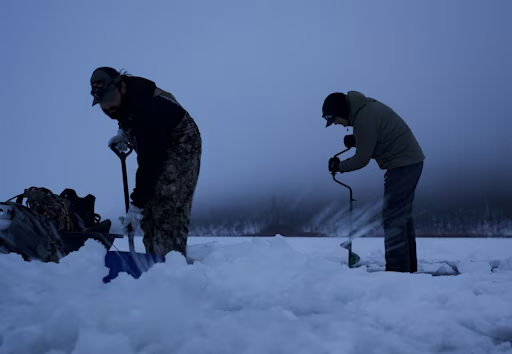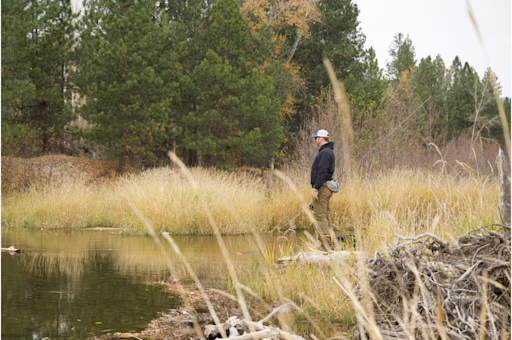Winter fly fishing tips
Winter comes with new and arduous challenges. Fish move to deep and slow water, your breathable waders may not be good enough and you may be sending in an order for a new rod tip. Learn how to extend your fishing season with the tips you need to stay out longer and catch more fish all winter long.
Share this article

Fly fishing in Montana often brings to mind early mornings on a pristine river set against a backdrop of mountains. You wade gently through the water, make a big looping false cast before delicately placing a dry fly right in front of a sipping trout.
That may sum up summer nicely, but good luck with all that in winter.
The mountains are now shrouded in fog and continuing snow, your pristine river is iced over in places and no trout is looking to sip anything off the chilled surface.
Fly fishing in winter is obviously a much different endeavor than the warmer months, but it is one that is absolutely worth being experienced.
If you can brave the temps and the slow fish activity, winter is actually a great time to be out on the water. The season offers solitude that is unheard of in summer, a silence only available when fresh snow lines the banks and the chance to dial in specific skills.
Below are some of Fishbrain’s tips specific to help you stay out later, and land fish on the fly during this beautiful time of year.
The basics
Deep water is the warmest water. Target fish at the bottom of pools
Try fishing the down stream side of dams
Chapstick prevents ice build up on guides
Don't fire out too early and dress to stay out all day

WATCH YOUR GUIDES
Anyone who has ever tried fishing in winter, knows the iced guides slow your fishing down, sometimes to a halt. As the water from your fly line passes through your guides, the air temp will freeze them over, nullifying your ability to cast. You can take time to remove the ice from each guide with your fingers, but you must be gentle, as this is a great way to snap a tip.
The better solution is to bring chapstick, or lip balm with you and thoroughly coat your guides before you hit the water. Most lip balms contain a certain percentage of petroleum based ingredients in them which will help prevent the buildup. It is important to note, however, an excessive amount of petroleum could damage the finish of a rod, or the coating on your fly line. If you’re worried about this, you can also try a bee’s wax based lip balm instead. The wax will do a similar job in preventing ice build up.
LAZY FISH IN DEEP WATER
The freezing water drastically slows a trout’s metabolism. This makes fish incredibly slow as they try to conserve calories in slow water. Slow deep water will also be the relatively warmest water on the river, making it a perfect spot to hold fish.
Try targeting dams that release water from the bottom, deep bailouts and other holding water where a fish can feel safe moving slowly on the bottom.
A lethargic trout in a deep pool is not going to go out of its way to grab your fly. These fish still need to eat, however.

If a good hole hasn't been spooked yet, try spending extra time on big deep holding water. More casts will more likely get right on top of holding trout, which is what needs to happen to get a strike.
Your best options are drifting nymphs, midges and San Juan worm patterns into these deep holes. You can try using strike indicators, or Euro nymphing tactics, both to great success.
Dead drifting and slow retrieving streamers can also entice a bite, especially on warmer days.
This is a great time to dust off the nymph box you’ve been neglecting and practice the basics.
DON’T GET TOO EAGER
We love fishing and generally we want to maximize our time doing it by getting out early. This is not productive in winter, however. Take your time, make breakfast and have that extra cup of coffee. Waiting for the warmest time of the day is going to make sure the fish are at their most active point of the day as well. It's going to be hard enough to entice a bite from one and you’re not doing yourself any favors by targeting them during their slowest point in the day.

STAY WARM AND STAY LONGER
The name of the game is “how long can you stay out”.
Waders are an obvious must this time of year, but your comfortable breathables may need to go. When the mercury plummets, your comfortable waders do not offer the insulation needed. The light weight material only our standard waders can also be damaged by the extreme temperatures.
This is a rotten time of year to find out you have a pinhole leak somewhere.
Try picking up a pair of neoprene waders instead, for these days. Five millimeter neoprene waders, or better yet seven, will keep you much warmer and out longer. Waders with rubber boots are also nice and warmer than stocking foot waders, but the tradeoff is they are less comfortable, especially if you are traveling long distances.
It may not be for the faint of heart, but winter should not shut down your fishing season. Being out on the water is the perfect cure for cabin fever and may even stop you from watching bone fishing videos.
You'll probably never go to Christmas Island anyways.

Get out there, freeze your fingertips and enjoy every minute of it. Winter is not to be dreaded, but is just another necessary season that we can choose to either enjoy, or be miserable during.
You can also just sit at your bench and tie flies all winter, too.
If you havent experienced the #1 fishing app worldwide, make sure and check out Fishbrain to see all the fish data, fishing spots, weather conditions you've been missing out on plus much more.

Download the Fishbrain app and access the best fishing spots in your area
Related blog posts
Master the hardwater season with advanced ice fishing tips . Learn how to find fish faster, refine your search and adjust presentations to catch more fish all winter long.

Your guide to Victoria’s best fish to catch in rivers, lakes, and coastal waters. Learn prime species, fishing tips, and key regulations

Learn how fish adapt as water temperatures cool from autumn to winter, including changes in behavior, metabolism, and habitat that help them survive.




